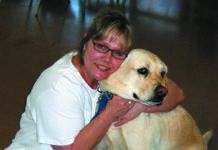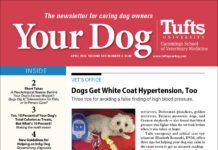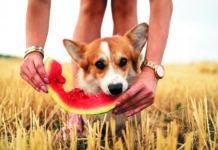Can the dog ever go off epilepsy medication if she stops having seizures?
Q: My 7.5-year-old cockapoo, Lila, has had epilepsy for the past five years. She is currently managed with phenobarbital, Keppra, and potassium bromide. In the early days before effective control, she would have as many as 15 seizures in three days every two weeks. Are there any studies that indicate epilepsy can resolve after a period of time? I raise this question because her medication has not changed for a long time, and she has gone from one seizure every couple months to none in over six months. This amount of medication, while useful for warding off seizures, seems to keep her docile and relatively inactive. If there was any proof of epilepsy resolving I would consider reducing the medication under the direction of her veterinarian.
Prison Puppies
We’re not talking here about canine prisons—puppy mills where dogs are kept in deplorable conditions. We’re talking about a program called Prison Puppies in which incarcerated men and women train puppies to become guide dogs and thereby help people in need. The program currently operates in prisons in Michigan and Minnesota.
When Eye Gook is Normal; When It’s Not
There’s whitish or clear gook in the inner corner of your dog’s eye. Should you be concerned? Nope. It’s a normal dog thing. Just put warm water on a cotton ball and wipe the lower lid to remove it.
Download The Full April 2024 Issue PDF
- Dogs Get White Coat Hypertension, Too
- Short Takes
- Yes, 10 Percent of Your Dog’s Total Calories as Treats, But What’s 10 Percent?
- New Guidelines for Helping an Itchy Dog
- But Wasn’t the Dog Dumped Because He Didn’t Make a Good Pet?
- When a Dog is Born with a Hole by His Heart
- How to Keep a Dog from Climbing the Canine Ladder of Aggression
- Dear Doctor
Dogs Get White Coat Hypertension, Too
High blood pressure readings at the veterinarian’s office can lead to an expensive workup that includes various blood screenings and other tests. After all, canine high blood pressure can be a sign of kidney disease and other serious conditions. But what if your dog simply has white coat hypertension — blood pressure that’s too high at the doctor’s office because of anxiety about being there but perfectly fine at other times?
A Psychological Reason Behind Your Dog’s Excess Weight?
More than 50 percent of dogs in the U.S. are estimated to be overweight. Part of the reason may be a psychological problem — yours. In many households, people turn food into currency for love. They fear that withholding as much food or as many treats as their dog wants will fray the bond they have with their pet. It won’t — if you show your pet love in all the other important ways.
Dogs Dig It
Different breeds of dogs dig for different reasons. Terriers, originally bred to dig for varmints that burrow into the ground, might dig fast and furiously in the dirt — or bed linens — to work through their hereditary instinct. They’re figuratively engaging in the so-called appetitive phase of preda-
tory behavior.
Telemedicine for Fido, or In-Person Care?
The COVID pandemic led to more Zooming and FaceTiming, including for veterinary care. And it may be easy to assume that most people have come to prefer such virtual vet visits because it’s more convenient than taking your dog to the doctor. But they don’t.
Yes, 10 Percent of Your Dog’s Total Calories as Treats, But What’s 10 Percent?
You may have heard that treats should make up no more than 10 percent of your dog’s calories. But if you don’t know how many calories your dog should be consuming in the first place, that advice isn’t so handy-dandy. Fortunately, there’s a formula for the right number of daily calories overall, at least if your dog weighs between 5 and 55 pounds: 30 x ideal weight (in kilograms) + 70.
New Guidelines for Helping an Itchy Dog
A healthy dog scratches himself so little that you don’t even really notice it, and he certainly doesn’t spend time biting or licking his coat. More than a few seconds of scratching here or there over the course of a day (or rolling against a surface to relieve itchiness), and there’s a good chance something is wrong.
But Wasn’t the Dog Dumped Because He Didn’t Make a Good Pet?
People often think that if a dog has wound up at a shelter after living in someone else’s home, it’s because he didn’t make a good pet. Maybe he kept soiling the carpet, they assume, or was aggressive, or just didn’t know how to get along with people. Or maybe he’s a wallet emptier due to ongoing health problems. In other words, the dog is believed to be damaged goods. But that’s very often not the case.
When a Dog is Born with a Hole by His Heart
When a developing puppy is growing inside his mother, he does not need to breathe. The oxygen he requires to mature in utero comes not from his lungs but from the umbilical cord. Thus, after coursing through the body, blood does not travel through the fetus’s lungs to pick up oxygen for another pump out to the body by the heart. The lungs remain deflated, and blood bypasses them through a kind of shunt called the ductus arteriosus.














